 Pine Technology
Pine Technology
Pine Technology Holdings was founded in 1989, producing hardware products for the PC market. Based in Hong Kong and with manufacturing facilities in China, they focused on graphics cards, sound cards, multi I/O cards, network cards and even produced some motherboards.
Their products tended to be low-budget offerings, sold mostly to OEMs and bespoke system builders.
Under the holding company were brands including Samtack in Canada and Pine Technology USA.
The table below summarises their expansion cards:
| ISA Cards | VLB / PCI / AGP Cards | Motherboards |
|---|---|---|
| Sound Cards PT200 (OPTi MAD16) PT201 (ES688) PT202 (Wavetable daughterboard) PT2019 (ES1698) PT2030 (Wavetable daughterboard) PT2321 (OPTi 82C931) PT2306 (ES1868) PT2316 (Avance Logic ALS100+) PT2326 (OPTi 82C931) PT2333/PT2339 (ES1869) PT2521 (YMF718) PT2526 (YMF718/YMF704) PT3201 (ES1868) |
PCI Sound Cards PT2620 (Crystal CS4280) PT2635 (ES1989 Allegro) PS-M01A (C-Media 8738) VESA Local Bus Graphics Cards PT524/8G (Cirrus Logic CL-GD524/8) PCI Graphics Cards PT540 (Trident TGUI) PT550 (Avance Logic 2302/1300) PT580E (IGA 1680/1682) Cirrus Logic Laguna Trident 9440 Trident 9680 Trident 9685 SiS 6215 AGP Graphics Cards PT5985 (SiS 300) PT5968 (SiS 6326) PT5986 (SiS 305) PT5988 (nVidia RiVA TNT2-M64) PV-S03A (SiS 305) PV-S04A (SiS 315) |
PT7000 (OPTi Viper) PT7502 (Intel 430VX) PT7504 (VIA VX Pro) PT8100 (Intel 440FX) |
Sound Cards
|
| JP1/JP2 | Base Address (jumpers oriented horizontally) | 220h: JP1 = 2-3, JP2 = 2-3 230h: JP1 = 2-3, JP2 = 1-2 240h: JP1 = 1-2, JP2 = 2-3 250h: JP1 = 1-2, JP2 = 1-2 |
|---|---|---|
| JP3 | IRQ (jumpers oriented vertically, with 1 and 2 to the left, and 3 and 4 to the right) | IRQ5: 1 and 2 open, 3 and 4 closed IRQ7: 1 and 2 closed, 3 and 4 open IRQ9: 1 and 2 open, 3 and 4 open IRQ10: 1 and 2 closed, 3 and 4 closed |
| JP4 | DMA Channel | None: 1 and 2 open, 3 and 4 open DMA0: 1 and 2 open, 3 and 4 closed DMA1: 1 and 2 closed, 3 and 4 open DMA3: 1 and 2 closed, 3 and 4 closed |
| JP5 | Joystick enable/disable | Enabled: closed Disabled: open |
The backplate's four jacks (from top to bottom with the card vertically installed) are: Mic-In, Line-In, Line-Out, Speaker-Out.
More Images
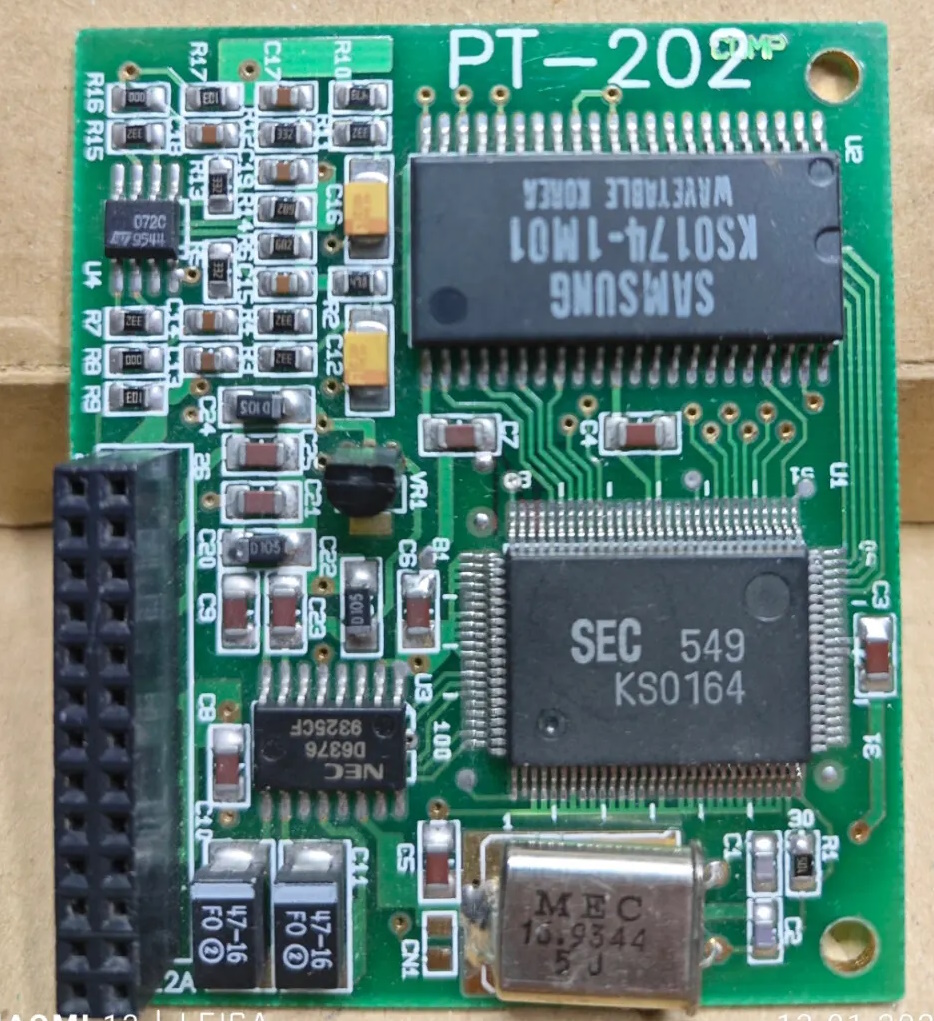 Vivaldi Wavetable Daughterboard (PT-202)
Vivaldi Wavetable Daughterboard (PT-202)
Introduced: 1995
Chipset: Samsung KS0164
ROM Size: 1 MB
Interface: Wave Blaster
Plug & Play: Yes
FCC ID: -
The Pine Vivaldi Wavetable Upgrade, as it was known, would have been the de-facto choice (in Pine's opinion, at least) for owners of cards like their PT-201, for wavetable synthesis capability. This provided General MIDI support in games when connected to any sound card with a Wave Blaster header.
Sadly, the Samsung OmniWave KS0164 which this uses isn't that great. Sure, for a budget wavetable offering, it will likely sound amazing compared to FM synthesis in your DOS games, but there are [and were] much better options, even in 1995. Apparently the KS0164 provides a subset of "intelligent mode" commands of the MPU-401 interface, which was something earlier games required, though this is most likely only a benefit if the KS0164 is used in a different scenario to wavetable daughterboards like this. The MPU-401 interface on your sound card is much more the critical component when looking for whether or not it supports intelligent mode (very rare) - most are UART-only.
More Images
.JPG) PT-2019
PT-2019 






Introduced: 1995
Bus: 16-bit ISA
Chipset: ESS Technology ES1698
Plug & Play: No
FCC ID: -
The PT-2019 was based on the sparsely-used ES1698 audio controller chip from ESS Technology - it's actually the only sound card I'm aware of that used this!
The ES1698 came with ESS Technology's embedded OPL3 clone, called "ESFM". Read more about one of my contributor's experience with this card on the ESS page.
Key Capabilties:
- ESS1698 chipset design with 20 voices / 72 operator FM music synthesizer
- Compatible with Ad Lib, Sound Blaster and Sound Blaster Pro, Windows Sound system, DOS, Windows 3.X, Windows 95, MPC and MPC-II
- On-board 3D surround sound
- 16-bit Stereo A/D and D/A
- Supports universal wavetable upgrade port
- ADPCM, ESPCM Audio Compression
- 4KHz - 44.1KHz sampling rate
- 6-channel mixer with software volume control
- Comes with licensed Willow Pond Sound Software
- Game port for external MIDI or joystick
- Record, compress & playback voice, sound & music
- Connectors for MIC in, line in, and 2 watts speaker out
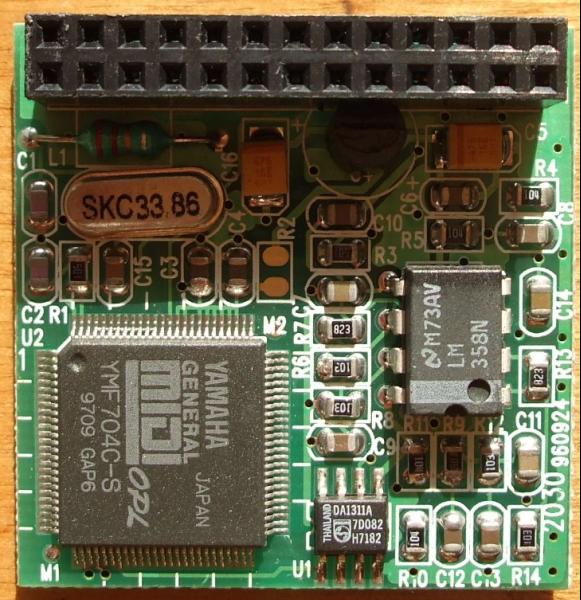 Vivaldi Xtra (PT-2030)
Vivaldi Xtra (PT-2030)
Introduced: -
Chipset: Yamaha YMF704
Interface: Wave Blaster header
Sample ROM: 1 MB
Plug & Play: Yes
FCC ID: -
The Pine Vivaldi Xtra (PT2030) was Pine's separate 24-voice wavetable daughterboard, compatible with the Wave Blaster header on any supported sound card.
Key features:
- YMF704 (OPL4-ML) wavetable chipset
- Complies with GM system level 1
- Generates up to 24 voices simultaneously
- Compatible with MPU-401 UART mode
- MIDI signal transmitted through serial or parallel input
- FM synthesis is register compatible with OPL3
- Power down function
.png) Schubert PT-2306
Schubert PT-2306 




Introduced: -
Bus: 16-bit ISA
Chipset: ESS ES1868
Plug & Play: Yes
FCC ID: -
The Pine Schubert ES1868 card is full duplex, which means that it can play and receive sound simultaneously. This makes it ideal for internet phone applications which involve two way communication. It is fully plug & play and features the new 3D binaural sound effect. This will enhance youur enjoyment of sound and is especially good for action games.
Key features:
- ESS1868 chipset design with ESFM synthesiser - 22 voices / 72 operators
- Compatible with Ad Lib, Sound Blaster and Sound Blaster Pro, Windows Sound System, Windows 95 DirectSound, Windows 3.1, DOS 5.0 or higher, MPC and MPC-II
- Fully plug and play
- Full duplex
- Supports universal wavetable upgrade port
- Serial Midi compliant
- 4KHz - 44.1KHz sampling rate
- 6-channel mixer with software volume control
- Binaura 3D surround sound chip
- Record, compress & playback voice, sound & music
- Connectors for mic in, line in, and 2 watts speaker out
- Game port for external MIDI or joystick
- Comes with licenced Willow Pond Sound Software
- MMCD Pine multimedia CD Rom available
More Images
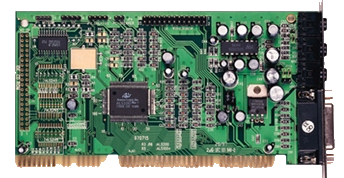 PT-2316
PT-2316 





Introduced: -
Bus: 16-bit ISA
Chipset: Avance Logic ALS100+
Plug & Play: Yes
FCC ID: -
Specifications
Digital Audio Features
 PT-2321
PT-2321 




Introduced: -
Bus: 16-bit ISA
Chipset: OPTi 82C931
Plug & Play: Yes
FCC ID: -
This PT-2321 was Pine's low cost sound card solution. It supported full duplex (it could play and receive sound simultaneously). This made it ideal for internet phone applications which involved two way communication. It was fully plug & play-compatible and featured Binaura 3D surround sound.
Key features:
- Opti 931 chipset design with 22 voices / 52 operator synthesiser
- Compatible with Ad Lib, Sound Blaster and Sound Blaster Pro, Windows Sound System, Windows 95 DirectSound, Windows 3.1, DOS 5.0 or higher, MPC and MPC-II.
- Fully plug & play
- Supports universal wavetable upgrade port
- Serial Midi compliant
- 4KHz - 48KHz sampling rate
- 7-channel mixer with software volume control
- Comes with licenced Willow Pond Sound Software
- IDE Interface
- Record, compress & playback voice, sound & music
- Full duplex, for internet phone
- Connectors for mic in, line in, and 2 watts speaker out
- Game port for external MIDI or joystick
- MMCD Pine multimedia CD Rom available
 PT-2326
PT-2326 





Introduced: -
Bus: 16-bit ISA
Chipset: OPTi 82C931
Plug & Play: Yes
FCC ID: -
This Opti 931 was one of Pine's low cost sound card solutions. It supported full duplex, was fully plug & play, and featured 3D Binaura sound.
Key features:
- Opti 931 chipset design, with 22 voices / 52 operators
- Compatible with Ad Lib, Sound Blaster and Sound Blaster Pro, Windows Sound System, Windows 95 DirectSound, Windows 3.1, DOS 5.0 or higher, MPC and MPC-II
- Fully plug and play
- Supports universal wavetable upgrade port
- Serial Midi compliant
- 4KHz - 48KHz sampling rate
- 7-channel mixer with software volume control
- IDE Interface
- Record, compress & playback voice, sound & music
- Connectors for mic in, line in, and 2 watts speaker out
- Game port for external MIDI or joystick
- Comes with licenced Willow Pond Sound Software
- MMCD Pine multimedia CD Rom available
 PT-2333 / PT-2339
PT-2333 / PT-2339 





Introduced: -
Bus: 16-bit ISA
Chipset: ESS ES1869
Plug & Play: Yes
FCC ID: -
Key features:
- ESS1869 chipset design, with 20 voices / 72 operators FM music synthesizer
- Compatible with Ad Lib, Sound Blaster and Sound Blaster Pro, Windows Sound System, Windows 95 DirectSound, Windows 3.1, DOS 5.0 or higher, MPC and MPC-II
- 16-bit Stereo
- ADPCM, ESPCM Audio Compression
- Sigma Delta Codec Compliant/Full Duplex monophonic mode/Half duplex stereo
- 4KHz - 44.1KHz sampling rate
- 85dB Signal-to-Noise Ratio for digita audio playback
- 6-channel mixer (CD, FM, Line In, Mic, Wave, Wavetable/MIDI)
- On-board 3D surround sound
- Supports dual game ports for external MIDI or joystick
- Connectors for MIC in, line in, and 2 watts speaker out
- Supports universal wavetable upgrade port for HW wavetable
- Supports headset and data paths for host-based Acoustic Echo Cancellation processing
- Comes with licensed Willow Pond Sound Software
 PT-2521
PT-2521
Introduced: -
Bus: 16-bit ISA
Chipset: Yamaha YMF718
Onboard Wavetable: Yes, software
Plug & Play: Yes
FCC ID: -
The PT-2521 Yamaha Software Wavetable was Pine's newest sound card in late 1998 (?). It featured the latest software wavetable technology, delivering OPL4-quality wavetable sound at a low price point. The card was fully plug & play and had a 3D surround sound feature.
Key features:
- Yamaha YMF718 (OPL3-SA2) chipset design
- Compatible with Ad Lib, Sound Blaster and Sound Blaster Pro, Windows Sound System, Windows 95 DirectSound, Windows 3.1, DOS 5.0 or higher, MPC and MPC-II
- 3D surround sound feature
- Software 32-voice software wavetable
- Fully plug and play
- Supports universal Wavetable upgrade port
- Serial Midi compliant
- 5.5KHz - 48KHz sampling rate
- 6-channel mixer with software volume control
- Comes with licenced Willow Pond Sound Software
- MMCD Pine multimedia CD Rom available
- Record, compress & playback voice, sound & music
- Full duplex, for internet phone
- Connectors for mic in, line in, line out and 2 watts speaker out
- Game port for external MIDI or joystick
 PT-2526
PT-2526 





Introduced: 1998
Bus: 16-bit ISA
Chipset: Yamaha YMF718
Wavetable: Yamaha YMF704 (OPL4)
Plug & Play: Yes
FCC ID: -
The PT-2526 was Pine's newest Yamaha Hardware Wavetable sound card in early 1999. It featured the latest Yamaha YMF704 wavetable chipset, delivering superb OPL4-quality wavetable sound. It was fully plug & play and had a 3D surround sound feature.
Key features:
- Yamaha YMF718 (OPL3-SA2) chipset design
- YMF704 (OPL4-ML) wavetable chipset, with 24-voice, 8-Mbit wavetable ROM
- 3D surround sound feature
- Compatible with Ad Lib, Sound Blaster and Sound Blaster Pro, Windows Sound System, Windows 95 DirectSound, Windows 3.1, DOS 5.0 or higher, MPC and MPC-II
- Fully plug and play
- Serial Midi compliant
- 5.5KHz - 48KHz sampling rate
- 6-channel mixer with software volume control
- Record, compress & playback voice, sound & music
- Full duplex
- Connectors for mic in, line in, line out and 2 watts speaker out
- Game port for external MIDI or joystick
- Comes with licenced Willow Pond Sound Software
- MMCD Pine multimedia CD Rom available
 PT-2620
PT-2620 




Introduced: -
Bus: PCI
Chipset: Crystal CS4280
Plug & Play: Yes
FCC ID: -
 PT-2635
PT-2635 




Introduced: -
Bus: PCI
Chipset: ESS ES1989 Allegro
Plug & Play: Yes
FCC ID: -
 PT-3201
PT-3201 






Introduced: -
Bus: 16-bit ISA
Chipset: ESS Technology ES1868
Plug & Play: Yes
FCC ID: -
This PT-3201 was based on the ESS ES1868 audio chipset. It supported full duplex (it can play and receive sound simultaneously) and came with onboard 3D spacial sound.
Key Capabilties:
- ESS1868 chipset design with ESFM synthesiser - 22 voices / 72 operators
- Compatible with: Ad Lib, Sound Blaster & Sound Blaster Pro, Windows Sound system, Windows 95 Direct Sound, Windows 3.1, DOS 5.0 or higher, MPC, MPC-II
- Fully plug and play
- Supports universal wavetable upgrade port
- Serial Midi compliant
- 4KHz - 44.1KHz sampling rate
- 6-channel mixer with software volume control
- Comes with Licenced Willow Pond Sound Software
- Connectors for mic in, line in, and 2 watts speaker out
- IDE Interface
- Record, compress & playback voice, sound & music
- Full duplex, for internet phone
- Supports game ports for external MIDI or joystick
- MMCD Pine multimedia CD Rom available
- Game port for external MIDI or joystick
 PS-M01A
PS-M01A 




Introduced: 1998
Bus: PCI
Chipset: C-Media 8738
Plug & Play: Yes
FCC ID: -
Graphics Cards
|
|
|
|
|
|
|
|
|
|
|
|
Motherboards
.jpg)
.jpg)
.jpg)
.jpg)
.jpg)
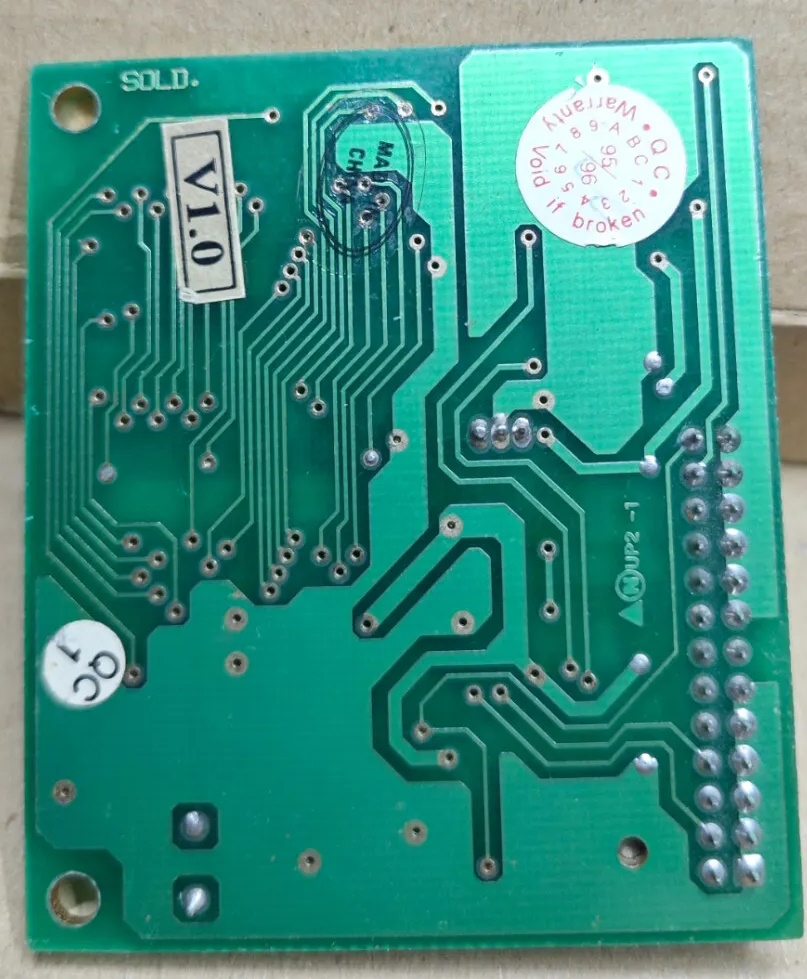
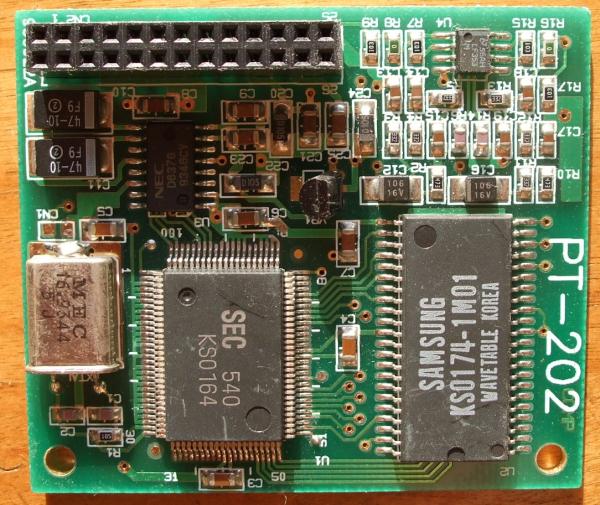
.jpg)
.jpg)
.jpg)
.jpg)
.png)
.png)
.png)